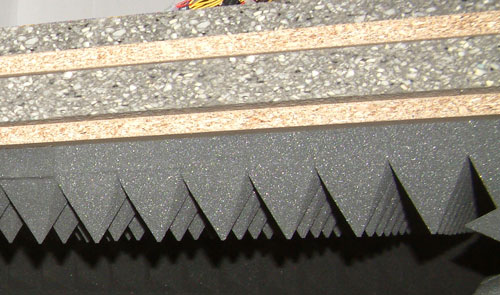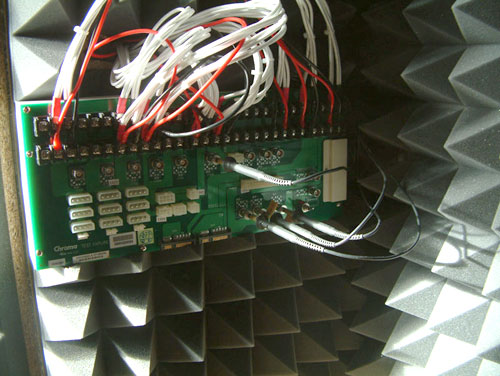Silverstone Zeus 1200W: Designed for the Power Hungry
by Christoph Katzer on July 7, 2008 2:00 AM EST- Posted in
- Cases/Cooling/PSUs
Testing with the Chroma ATE Programmable Load

Our test equipment consists of two Chroma programmable DC Loads that enable us to test power supplies with an output of up to 1500W. The biggest advantage of the Chroma DC Loads is simply the high precision it provides. It can measure differences as small as 0.001V and 0.0001A, which will provide us with best-in-class results.
When programming the Chroma with specific amounts of load calculated according to the ATX norm, we are able to load power supplies to an exact percentage. We can now show results at every specific percentage needed. To get the best overview of a power supply, we load each unit with 10%, 20%, 50%, 80%, 100%, and 110% of the specified output. This is easy to calculate for a 1000W power supply: the 10% load is 100W and 110% load is 1100W. Remember that this is the amount of power the PSU delivers; due to inefficiencies, a power supply will actually draw more power from the wall.
Note: If you would like to know more about our testing methodology, equipment, and environment, please read our PSU testing overview.
We have added an additional 10% on the highest load to see how the units perform with overload. This test will be performed in all future reviews. The overload test is performed at room temperature as well as under more stressful conditions; to ensure we are not too cruel to the power supplies, we will keep the ambient temperature at 50°C in the stress test. Experience shows that many units can stand the overload at room temperature but will experience problems with higher temperature and overload together. Only the best-built units will survive this.

The Testing Environment
There is one flaw in testing power supplies with programmable loads while trying to measure the sound pressure levels at the same time. Because the programmable loads get very loud, there is no chance of hearing the power supply on the test stand. In order to make accurate measurements of the noise levels we needed a way to separate the test unit and the programmable loads. Our solution was to build a very thick box around the unit.

We concluded that a five-layer box with a total thickness of 6" (15cm) containing two layers of wood and three layers of special foam would suffice. It is designed as a box within a box. The inner box does not touch any part of the outer box, making it difficult for acoustic noise to pass through in the form of vibration. Each box is isolated on both sides with a layer of heavy foam that is normally used to insulate engines. On the inside we have an additional layer of 4" (10cm) thick pyramidal foam on every side of the box to eliminate the acoustic waves coming from the test object as well as we can.

To ensure a completely closed system we installed the printed circuit board that the connectors of the power supply are attached to inside the anechoic room/box. In other box designs, you would need to put all the cables through the wall. Unfortunately, that would result in the inside of the box not being fully isolated anymore. Our design keeps everything that needs to be connected inside of the box and maintains isolation.










20 Comments
View All Comments
BustedSony - Monday, July 7, 2008 - link
Electrical work is expressed in terms of POWER. DC power uses Watts as the unit. Watts = Voltage times Amps. Thus with perfect efficiency 120 watts can be obtained EITHER with 12 volts at a 10 amp load, or 120 volts at a 1 amp load.Thus 12 volts running 100 amps = 1200 Watts. 120 volts running just 10 amps also equals 1200 watts. The difference in power available versus power drawn from the wall is loss of efficiency, generated mostly as heat.
According to Ohms law current (amps) = voltage divided by resistance. Thus 10 amps would be drawn by 120 volts across 12 Ohms, or 12 volts across 1.2 Ohms.
mattclary - Monday, July 7, 2008 - link
Ahhhhhh, thank you! At one time I knew Ohm's law, but had forgotten the role voltage played!RamarC - Monday, July 7, 2008 - link
will other manufacturers start using the deity naming scheme? are the Corsair Ra and OCZ Shiva next?yacoub - Monday, July 7, 2008 - link
No dude, Zeus is purposeful: He carries a lightning bolt. See the line Samuel L. Jackson delivers in Die Hard 3.Merman - Monday, July 7, 2008 - link
[quote]The quality of each rail is also surprisingly good. Ripple on the lower voltage rails doesn't reach higher than 4mV, and the 12V rails don't reach more than 12mV even with full load. At lower loads, the 12V rails are also around 4 to 8mV which is a very good result.[/quote]Finally talking about power quality again.
Considering the ATX12V specification is a maximum of 120mV peak to peak is this result not outstanding and probably the best available on the market???
Or is there a discrepancy in measurment with ATX specifications???
It would be nice to compare ripple results from this site with the other top power supply review sites.
If for some reason this is not possible please educate us rather than take the position that most don't understand this subject nor care.
C'DaleRider - Monday, July 7, 2008 - link
I still find those ripple/noise generation findings a bit on the fantastic side. If they are what are represented, this means it blows PCP&C's best out of the water for controlling ripple and noise generation at full output.But, while Impervio is good at power supply manufacture, and this was made by Impervio, not Enhance as stated in the article, I sincerely doubt it actually measured only 12mV at full load and only 4-8mV otherwise on the +12V rails. Those figures are just too damned fantastic to be real. And to call them only "good"? They should have been labeled "The best" or "fantasy".
Christoph Katzer - Monday, July 7, 2008 - link
Impervio doesnt have own production facility and produces at Enhance instead.Christoph Katzer - Tuesday, July 8, 2008 - link
This unit is made by IS Quasar. A factory with several robotic assemblers in Taiwan. Almost all of the Silverstone models we reviewed so far came from there.Adamantine - Monday, July 7, 2008 - link
Or could label them as "godly".coolsam2 - Monday, July 7, 2008 - link
first to post a comment.. sry 4 wasting u precious 2 seconds..